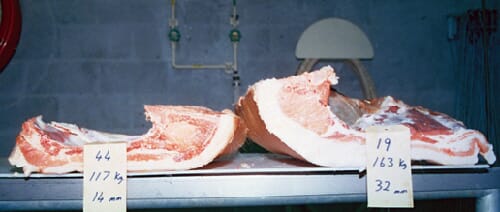Synthetic amino acids can be used to lower crude protein, which in turn reduces ammonia production and has no negative impact on performance, you would believe that the issue of ammonia is solved. However, synthetic amino acids can only be used to drop crude protein by a certain level before negative impacts can be seen on performance. To drastically change the ammonia production from pork, lowering crude protein with synthetic amino acids will not solve the problem completely.
A recent review by Wang et al. (2018) highlighted that a 3% drop in crude protein with lysine, methionine, threonine and tryptophan is sufficient to supporting a similar performance as a high protein diet. Dropping the crude protein further than 3% with only the four amino acids supplemented results in reduced performance which can be alleviated with the supplementation of additional amino acids such as valine, and isoleucine. Dropping protein 6% would require the supplementation of all essential amino acids.
While a 6% drop in crude protein without a negative impact on performance would benefit the environment, economically the cost of the diet will increase drastically due to the high inclusion of synthetic amino acids. Furthermore, the environmental benefit may be offset by the environmental impact of synthetic amino acid production. A diet containing high levels of synethetic lysine, methionine, threonine, tryptophan and valine results in a similar carbon output per kg of feed compared to a typical soyabean-maize finisher diet, while the carbon footprint of the livestock fed on this diet was higher when compared to a standard soya-maize diet (Cherubini et al., 2015).
Carcass Performance
Historical work by Harper (1959) suggested that when a diet results in an imbalance of amino acids either due to an excess or lack of one or more amino acids, growth performance and feed intake is restricted. Building on this theory Pencharz and Ball (2003) suggested the imbalance could lead to a reduction in protein synthesis as the excess amino acids are oxidised rather than used for protein synthesis. As synthetic amino acids are absorbed faster than protein-bound amino acids, high levels could lead to an amino acids imbalance. While current studies suggest no negative impact on growth or feed performance, a study by Lambe et al. (2013) highlighted that pigs fed on a low protein diet produced carcases with increased fat and reduced muscle content compared to those fed a high protein diet.

While synthetic amino acids do have a role to play in improving the environmental impact of pork production, using excessive amounts that create fatter carcases will not be sustainable. Firstly, it is more energy intensive for a pig to lay down fat so feed conversion will be negatively impacted and the increased fat will result in penalties’ from the abattoir if above the market specification (12mm). This combination will result in decreased economic performance for the producer. Secondly, the demand for pork may decline if the selection of products become higher in fat due to consumer perspective of the negative health impact of high fat food; consumers will simply substitute pork for lower fat products such as chicken. If this scenario occurred on a large scale, the demand for pork will decline, in turn driving down the price paid to the producer.
Lowering crude protein is an easy strategy for producers to implement in order to improve their environmental footprint, especially with the use of synthetic amino acids. Careful decisions need to taken in order to ensure that the diet is not only sufficient in all amino acids but that it will not result in excess amino acids leading to amino acid imbalances.
References
CHERUBINI, E., ZANGHELINI, G., TAVARES, J., BELETTINI, F. & SOARES, S. 2014. The finishing stage in swine production: Influence of feed composition on carbon footprint. Environment Development and Sustainability, online, in press.
HARPER, A. .1959. Amino acids balance and imbalance: I. Dietary level of protein and amino acid imbalance. The Journal of Nutrition, 68(3) pg. 405-418.
LAMBE, N. R., WOOD, J. D., MCLEAN, K. A., WALLING, G. A., WHITNEY, H., JAGGER, S., FULLARTON, P., BAYNTUN, J. & BÜNGER, L. 2013. Effects of low protein diets on pigs with a lean genotype 2. Compositional traits measured with computed tomography (CT). Meat Science, 95, 129-136.
LINDEN, J. 2014. Controlling High Backfat (P2) in Finisher Pigs. Available at: hepigsite.com/articles/controlling-high-backfat-p2-in-finisher-pigs [Accessed 12/2021]
PENCHARZ, P. & BALL, R. 2003. Different approaches to define individual amino acid requirements. Annual Review of Nutrition, 23, pg 101-116.
WANG, Y., ZHOU, J., WANG, G., CAI, S., ZENG, X. & QIAO, S. 2018. Advances in low-protein diets for swine. Journal of Animal Science and Biotechnology, 9.